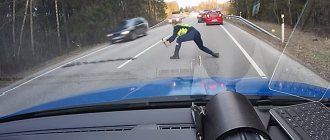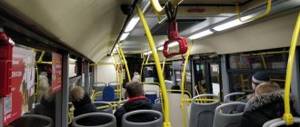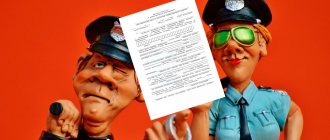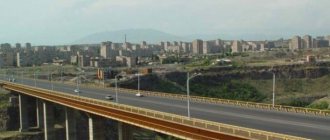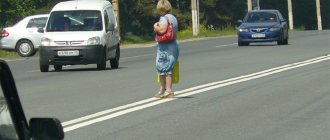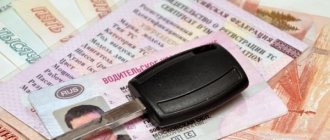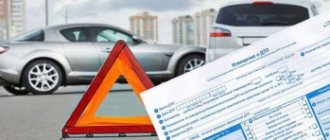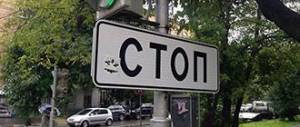Navigating the rules can sometimes be quite difficult.
It’s good if road signs tell you what you can and cannot do on a given section of the road.
What to do if behavior on the road is not determined by signs?
It is proposed to remember the not so simple part of the traffic rules - stopping on the bridge, specify the area of the ban and remind about exceptions to the rules.
Is stopping on the bridge allowed?
So, is it possible to stop on the bridge? Before discussing possible bans, it is proposed to differentiate between bridges, overpasses and overpasses.
A bridge is an artificial structure that is erected over rivers and other water barriers; an overpass and overpass are intended to pass over land objects.
You cannot stop on artificial structures designed to pass over a water obstacle.
This prohibition applies to vehicles crossing the bridge if the number of vehicle lanes in a particular direction is less than three.
It is strictly forbidden to stop on bridge structures not on a whim, but due to a number of objective factors. The most important of them are:
- limited space;
- increased pressure on bridge supports.
They are united by the danger of placing a large number of vehicles on the road section in question.
Violation of the rule entails negative consequences for the wallet and psyche of the motorist. Penalties for parking on the bridge include payment of 2,000 rubles. In Moscow and St. Petersburg the punishment is harsher. There you will have to pay 3000 rubles.
In addition, if the rules are violated, the following measures are applied:
- detention of a vehicle;
- placing the offender's car in a specialized paid parking lot.
There are exceptions to the rule. Knowing about them, you can prevent a number of problems associated with non-compliance with traffic rules.
When is stopping allowed?
It is proposed to consider in detail the situations when a motorist can interrupt the movement.
You are allowed to stop in the following cases:
- in front of the bridge;
- after the bridge;
- on a bridge if certain requirements for the roadway are met and there are no prohibiting signs;
- in case of sudden problems with the car or its driver, forcing you to stop in the interests of traffic safety;
- at the request of the inspector, which is a priority on the road.
Interestingly, the rules do not regulate the beginning and end of the bridge in any way. There are no special signs that would help to unambiguously determine the length of this structure. The traffic regulations do not provide for the installation of technical means warning of entry onto the bridge. There is only one way out: the car enthusiast will have to solve this problem on his own.
In search of an answer to the question posed, one has to turn to regulatory documents from other areas. The current GOST 33178-2014 defines the length of the bridge as “the distance along the axis of the bridge between the ends of the abutments or other visible structural elements of the abutment or span adjacent to the embankments of the inlets,” and emphasizes that it is measured without taking into account the transition slabs. This difficult formulation does not make the life of a car enthusiast any easier.
The boundaries of an artificial structure can be considered its foundations, that is, the supports located along the edges. Indirect evidence of entry to the bridge is a sign with the name of the bridge or the river it crosses. The appearance of characteristic enclosing elements is considered as the boundaries of the bridge.
The beginning of the bridge construction is indicated by a rise. All this leads to a variety of subjective perceptions of the same situation by different road users and entails the emergence of a conflict of interests between motorists and authorities.
Since there are no clear instructions regarding the definition of the boundaries of a bridge structure in the traffic rules, the final word remains with a specific inspector or judge.
Does a traffic inspector have the right to stop on an overpass or bridge?
Order No. 185 of the Ministry of Internal Affairs allows traffic police officers to stop drivers in places where stopping is prohibited by the rules, but for this there must be really compelling reasons, such as:
- signs of a serious violation of traffic rules by the driver;
- orientation towards a person or a car;
- in the event of an accident - the need to interview witnesses to the accident;
- in case of an accident - for regulatory actions;
- in rare cases - to create safe movement of organized groups with escort;
- if necessary, let an ambulance, fire truck or other special services vehicles pass;
- the need to help victims on the road;
- if the car is moving in a visually defective condition and may cause danger to other road users.
That is, if, for example, there is a serious accident ahead or the driver of the car looks like the criminal who was identified, the inspector has the right to stop the car anywhere, including on a bridge.
Signs
A special “Bridge” sign has not yet been created.
Nevertheless, the traffic rules consider technical means that prompt the driver about driving on the bridge and thereby warn about the corresponding restrictions. It is suggested that you pay attention to them.
So, the appearance of the following signs indicates that a car is entering the bridge:
- 3.11 “Weight limit” means a ban on the movement of vehicles with a weight exceeding the specified one.
- 3.12 “Limitation of mass per axle of a vehicle” does not allow further movement of vehicles whose actual mass per axle exceeds that prescribed by the sign.
- 1.9 “Drawable bridge” is installed in front of bridge structures that have a movable span to ensure the passage of ships.
- 1.29 “Crosswind” is located in front of sections of roads passing over bridges, etc., where strong crosswinds are possible.
The first two points are represented by technical traffic safety means from the prohibitive category.
They are a circle with a red border around the perimeter. The effect of these signs begins right from the place where they are installed.
The last two points include warning signs. They look like triangles with a thick red border around the perimeter.
Information about the nature of the possible danger is schematically depicted on a white background. Knowing the distance from the sign installation to the beginning of the dangerous section, the driver will be able to determine the moment of entering the bridge.
On the one hand, such a number of signs indirectly indicating the entrance to the bridge does not make life easier for the motorist. On the other hand, the absence of these signals will help prove in court that the stop was not made on the bridge, therefore, the rules were not violated.
Let's remember the traffic rules course: is it possible to park on a traffic island?
Markings in the form of traffic islands and guide islands are designed to protect pedestrians and also help indicate the direction of traffic flow.
But due to the sharply increasing number of personal cars, drivers are beginning to use such markings for other purposes, for which they receive fines.
In the article we will examine in detail whether it is possible to cross, as well as park or stop on the islands.
When is this allowed and not a violation?
Valid reasons for stopping or parking may be:
- forced stop due to vehicle malfunction;
- the driver felt unwell and could not continue driving.
The rules allow for situations where a motorist is forced to park on an island.
Attention! Don't forget to turn on your emergency lights and put up the necessary sign if you really break down and have to stop
What fine and/or other sanctions are provided?
There is no direct prohibition on performing the maneuver in the traffic rules. A traffic police inspector can issue a fine based on the fact that the driver violated the marking requirements (you can find out how long the fine for parking in the wrong place is to pay and whether there is a statute of limitations here).
The standards indicate that elements directing movement (islands) are indicated by a solid line and inclined ones. Line 1.1 serves to mark the boundaries of roadways that prohibit driving through them.
- If marking rules are violated, i.e. crossing the lines delineating the traffic island, the motorist will be fined under Part 1 of Article 12.16 of the Administrative Code - he is charged with incorrectly observing the traffic rules prescribed by road markings. A fine can be issued in the amount of 500 rubles.
- Violating the rules provided for by traffic rules for stopping and parking, under Part 1 of Art. 12.19 of the Administrative Code, a motorist risks receiving a fine of 500 rubles, which can be replaced with a warning.
- Another option could be a sanction of 1,500 rubles, according to Part 3.2 of Art. 12.19 of the Administrative Code, for violation of parking and stopping further than the right lane from the edge of the roadway.
- And if the island was located near a pedestrian crossing, then you will have to pay 1000 rubles, this is regulated by Part 3 of the same article.
Controversial situations and ways to avoid punishment in such cases
Controversial issues also exist in such cases. You were given a fine for violating the markings, but the stop was forced. There are two situations worth considering here:
- The traffic police inspector issues a fine - if the car is really faulty, then you can explain the situation to the traffic police officer on the spot and thereby avoid a monetary penalty.
- The violation was recorded on camera - here the judge will have to prove his case. The camera only takes photos, so it is not clear whether you stopped due to a technical fault or are simply violating traffic rules. In this situation, you can try to explain in court that you did not plan to park, and the stop occurred out of necessity.
It is also necessary to check the articles specified in the protocol; if you were given a fine under an article that does not correspond to your violation, then such a decision can be challenged.
How can the traffic police prove your guilt?
When drawing up a report on an offense, the traffic police officer must provide compelling evidence of what happened. As a rule, materials on the violation made using video or photography are attached to the case.
The capabilities of modern technical devices make it possible to create an evidence base that illuminates the picture of the event with extreme clarity. If possible, the traffic police officer will certainly try to stock up on witness statements. To do this, directly at the place where the protocol was drawn up, eyewitnesses of the violation are asked to give testimony.
In large cities, violations of marking rules (crossing a traffic island) are recorded using automatic video cameras installed throughout the city. And in this case, the driver will receive the decision by mail in the form of a “chain letter”.
Number of lanes
Many rules have exceptions. There is also a nuance to the ban on parking on bridges.
Two lanes in one direction clearly prohibit stopping at the structure.
The presence of three lanes when driving in one direction allows for a short stop.
There is logic in this decision. By occupying one of the available lanes in two-lane traffic, a vehicle will inevitably create an obstacle to the movement of other vehicles on a narrow bridge.
3 lanes help to avoid traffic interference; in such cases, stopping on the bridge is permitted. Cars stopped on such bridges do not prevent other cars from changing their position in space and do not create prerequisites for testing the bridge structure to its ultimate strength.
Traffic restrictions that exist on narrow bridges do not matter on three-lane river crossings.
Signs and markings significantly simplify the life of a motorist, telling them what can be done on a particular section of the road and what is strictly prohibited. The case under consideration seems more complex, since the prohibition is sometimes not indicated in any way and at the right time must emerge from the depths of the driver’s memory.
Section 12 of traffic rules: stopping and parking
The ban on parking on this section of the road is due to the high speed of traffic outside the populated area. Especially if the traffic is on the main road. In such conditions, a vehicle standing on the roadway will be a clear obstacle. And if a short stop here is allowed, then parking using the roadway is excluded by the Rules for reasons of basic safety.
Let us note only one important circumstance: the presence of both signs and markings is an incomparable benefit for the driver. And all because they are a very clear way to regulate stopping and parking, and the car owner can see with his own eyes the correctness (or, unfortunately, incorrectness) of his actions.
